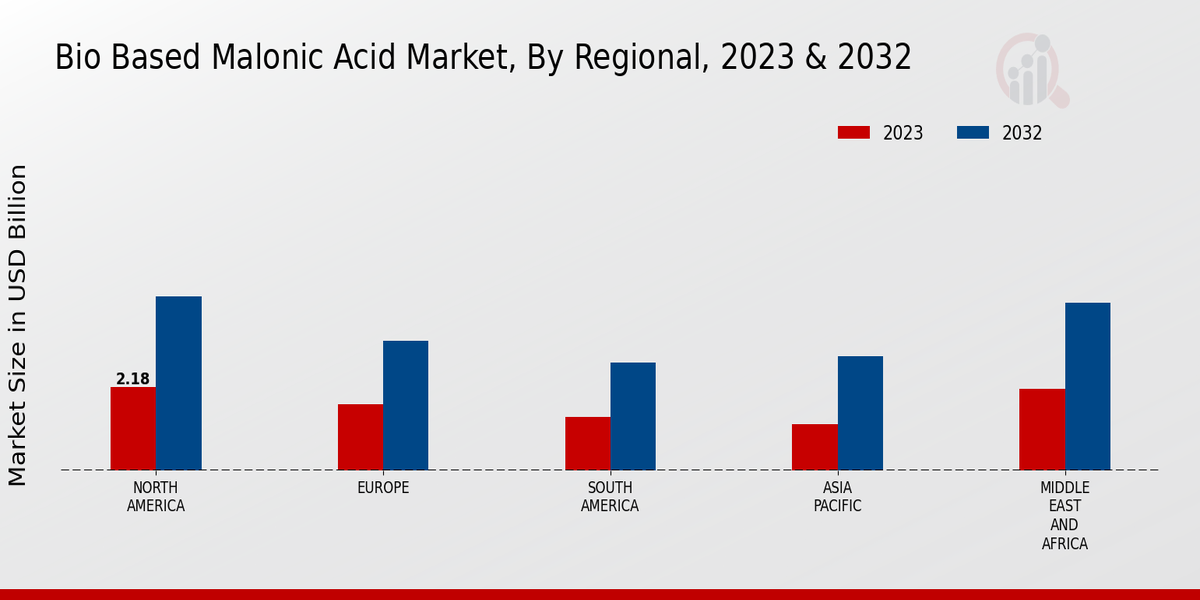Market Growth Projections
The Global Bio-based Malonic Acid Market Industry is projected to experience substantial growth in the coming years. The market is expected to reach 10.2 USD Billion in 2024 and is forecasted to grow to 25.4 USD Billion by 2035. This growth trajectory suggests a robust expansion, driven by increasing demand for sustainable chemicals and advancements in production technologies. The anticipated CAGR of 8.64% from 2025 to 2035 indicates a strong market potential, reflecting the industry's ability to adapt to changing consumer preferences and regulatory landscapes.
Advancements in Production Technologies
Technological advancements in the production of bio-based malonic acid are significantly influencing the Global Bio-based Malonic Acid Market Industry. Innovations in fermentation processes and enzymatic pathways have enhanced production efficiency and reduced costs. For example, the adoption of genetically modified microorganisms has been shown to increase yield rates, making bio-based malonic acid more competitive against petroleum-derived counterparts. As production technologies continue to evolve, the market is likely to see a substantial increase in output, potentially leading to a market valuation of 25.4 USD Billion by 2035. This technological evolution is crucial for meeting the anticipated demand and ensuring the industry's sustainability.
Growing Demand for Sustainable Chemicals
The Global Bio-based Malonic Acid Market Industry is experiencing a surge in demand for sustainable chemicals as industries increasingly prioritize eco-friendly alternatives. This shift is driven by regulatory pressures and consumer preferences for greener products. For instance, the market is projected to reach 10.2 USD Billion in 2024, reflecting a growing inclination towards bio-based solutions. Companies are investing in bio-based malonic acid production to meet these demands, which not only reduces carbon footprints but also aligns with global sustainability goals. This trend indicates a robust growth trajectory for the industry, as stakeholders recognize the potential of bio-based chemicals in various applications.
Regulatory Support for Bio-based Products
Regulatory frameworks supporting bio-based products are playing a pivotal role in shaping the Global Bio-based Malonic Acid Market Industry. Governments worldwide are implementing policies that encourage the use of renewable resources and penalize excessive reliance on fossil fuels. For instance, initiatives such as tax incentives and subsidies for bio-based product development are fostering a favorable environment for manufacturers. This regulatory support not only enhances market attractiveness but also drives investment in research and development. As a result, the industry is expected to grow at a CAGR of 8.64% from 2025 to 2035, reflecting the positive impact of these regulations on market dynamics.
Expanding Applications in Various Industries
The versatility of bio-based malonic acid is contributing to its increasing adoption across various industries, thereby driving the Global Bio-based Malonic Acid Market Industry. Applications range from pharmaceuticals to agrochemicals, where malonic acid serves as a key intermediate in the synthesis of numerous compounds. The growing interest in bio-based alternatives in these sectors is indicative of a broader trend towards sustainability. As industries seek to replace traditional petrochemical products with bio-based options, the market is poised for significant growth. This diversification of applications is likely to enhance market stability and resilience against economic fluctuations.
Consumer Awareness and Preference for Green Products
Consumer awareness regarding environmental issues is significantly influencing the Global Bio-based Malonic Acid Market Industry. As consumers become more informed about the ecological impacts of their choices, there is a marked shift towards products that are perceived as environmentally friendly. This trend is evident in the increasing demand for bio-based malonic acid in consumer goods, where manufacturers are responding by reformulating products to include sustainable ingredients. The growing preference for green products is not only reshaping market dynamics but also encouraging companies to innovate and invest in bio-based alternatives, further propelling the industry's growth.












